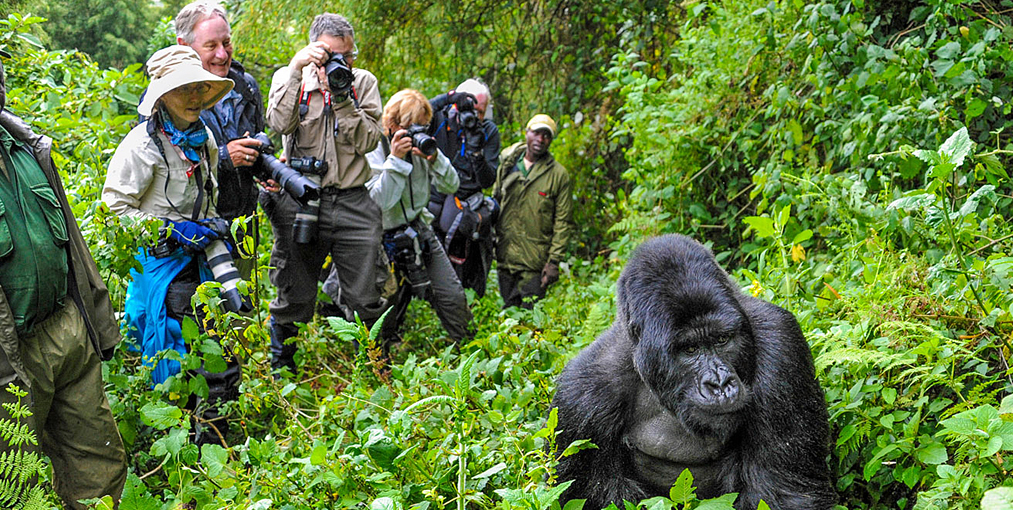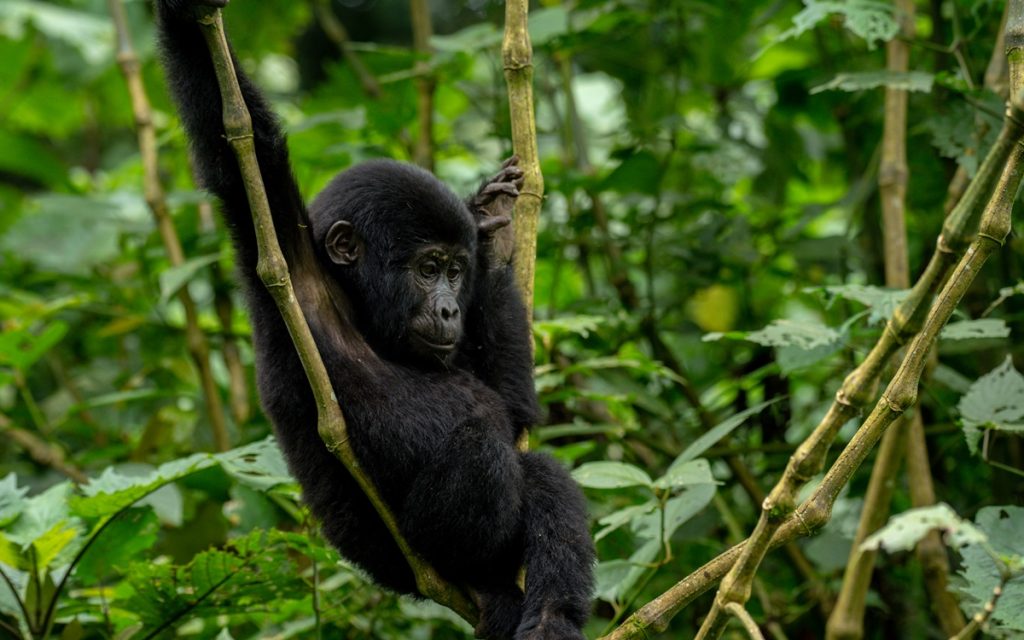- Written by: Anthony
- June 24, 2025
How many gorillas are left in the wild?
How many gorillas are left in the wild?
As per the latest gorilla population census conducted in 2024, only 320,000 total gorilla individuals are estimated to be remaining in the wild.
In contrast to the fact that other (most) gorilla species can survive in captivity such as zoos, it’s worth noting that mountain gorillas cannot.
Out of the 320,000 gorillas, over 316,000 of them are western gorillas and about just about 5,000 of them are eastern gorillas.
Much as the western gorilla population is the highest comprising majorly of the western lowland gorilla, this number is expected to greatly decline due to destructive human activities and behaviors such as habitat destruction and poaching.
The eastern gorilla species comprises of the beautiful, adorable and thick black-furred mountain gorilla sub specie and the grey-haired eastern lowland gorillas.

A group of mountain gorillas in Bwindi
Out of them all, Mountain gorillas have the lowest numbers, considered the most rewarding to trek however, their population has recorded an increase to about 1,063 individuals as of 2024, thanks to conservation efforts.
One of the main reasons why mountain gorillas are considered unique include; Their beautiful and thick fur, mountain gorillas can only live in mountainous areas and not found in the zoos.
In contrast, the eastern lowland gorillas have seen a significant decline in numbers, with an estimated total of just 5,000 individuals or fewer remaining in the wild.
Another subspecies, the Cross-River gorilla, a critically endangered subspecies known for being human unfriendly and the smallest subspecies records only a total of just 250 gorillas remaining in the wild.
Considering the numbers, it’s without a doubt that Conservation efforts must consistently continue if the number must increase.
How many mountain gorillas are left in the world?
As per the latest mountain gorilla population census conducted in the Congo, Uganda and Rwanda, just 1,063 (One thousand and sixty-three) estimated total was recorded.
Much as the number may seem low, mountain gorillas have recorded an increment in numbers since the last census.
Red listed by IUCN as critically endangered, your only destinations to sightsee mountain gorilla sin their natural habitat include; the Virunga Volcanoes in the Democratic Republic of Congo, Rwanda, and Uganda, and Bwindi Impenetrable National Park in Uganda.
Gorilla numbers vs sub species.
| Species | Scientific name and subspecies | Size and ecology | IUCN status and estimated number |
| Eastern Gorilla (G. beringei) | G. b. beringei (Mountain gorilla) | Size: 160-195cm long. Habitat: Forests | 1,063 gorillas, Critically endangered. |
| G. b. graueri (Eastern lowland gorilla) | Size: 160-195cm long. Habitat: Forests | 5,000 gorillas, Critically endangered. | |
| Western Gorilla (G Gorilla) | G. g. diehli (Cross River gorilla)
|
Size: 130-185cm long. Habitat: Forests | 250 gorillas, Critically endangered. |
| G. g. gorilla (Western lowland gorilla) | Size: 130-185cm long. Habitat: Forests | 260,000 gorillas, not endangered. |
Why are gorillas’ population reducing?
Habitat Loss
Since gorillas are generally huge in sizes, they require huge amount of vegetation to feed on a daily basis and therefor, they need large forested areas to survive but human activities such as logging, mining, and agriculture have destroyed much of their natural habitat – greatly affecting their population.
Other urbanization practices such as roads construction that cut through their territories, and once forests are fragmented, gorillas become easier targets for poachers and more vulnerable to human-wildlife conflict.
Poaching
In addition to habitat loss, poaching remains another big threat to these majestic primates. The locals in gorilla communities illegally hunt these gentle giants for bushmeat or captured for the exotic pet trade.
Poaching also affects them indirectly—snares set for other animals often injure or kill gorillas.
Much as the destination countries are imposing great laws against this practice, enforcement is weak in remote areas making this a great threat and setback to all conservations efforts.
Suggested Safari Itineraries
Disease
Gorillas are susceptible to human diseases and sicknesses, therefore Human-transmitted diseases, especially respiratory infections and viruses like Ebola, have wiped out entire groups of gorillas.
Since gorillas share great genetic similarity to humans, this makes them extremely vulnerable to human-like diseases and illnesses.
The government in gorilla countries have since encouraged ecotourism in attempt to ensure conservation.
Civil Conflict
Several political insecurities along the gorilla parks has greatly led to a reduction in gorilla numbers. For example, in the Democratic Republic of Congo, gorilla population has greatly reduced and trekking has even become harder—making it hard for conservation teams to monitor and protect them.
Several rangers who look out and protect for these gentle giants have been killed while on patrol. In unstable zones, poaching and illegal land use often go unchecked.
Climate Change
Shifting rainfall patterns and temperatures are affecting the forests gorillas depend on. Plant life cycles are changing, food sources become scarce, and new diseases spread faster. While climate change is a slower threat, it adds pressure on already fragile populations.
Slow Reproduction
Gorillas are giants and one thing about giants – they don’t reproduce weekly or monthly, some of them don’t even reproduce yearly.
This is no exception for gorillas, the female gorillas give birth about once every four years, and infant mortality is high. This slow reproductive rate makes it hard for populations to recover quickly after losses from poaching, disease, or habitat destruction.

A mother and baby gorilla in Rwanda’s Volcanoes National park
Gorilla Population FAQ
How many silverback gorillas are left?
The exact number of silverback gorillas remaining in the wild is un known however, every gorilla group has one or more silverbacks.
How many gorillas are in Uganda?
Uganda has only mountain gorillas and the total estimated number is 459. These gorilla population is spread through out the two gorilla parks of Bwindi and Mgahinga.
Recommended Safaris

Gorillas in the Wild
Which countries has the most gorillas?
As you already know, its no secret that the majority of gorillas are the Western lowlands with the largest numbers in the Democratic Republic of the Congo totaling to a recorded number of up to 200,000 individuals.
Uganda on the other hand is the country with the highest numbers of mountain gorillas in Africa with over 25 habituated gorilla families that may be trekked.
Uganda’s gorilla parks attract most trekkers compared to other neighboring gorilla parks due to its relatively lower permit cost.
Can gorillas live 100 years?
Gorillas cannot live up to 100 years. The gorilla lifespan in the wild is approximately 35 years however, in captivity, gorillas may live up to 50 years.
Conclusion
There are just a few of the accessible gorillas and standing in front of these gentle giants is a lucky life-changing opportunity, only experienced by a few.
If you need help planning a safe, memorable and exciting gorilla trek to Uganda or Rwanda, get in touch and we shall be happy to help.
Anthony

Ready for your ultimate wildlife experience?
Chat with us, our team is always here to help!
You may also like …

Got any questions
about traveling to Uganda?
Get in touch.








